
The Sound of Strymon: Sound Designer Pete Celi
Strymon co-founder Pete Celi is responsible for the sound design and DSP algorithm creation for all the Strymon pedals that use DSP. Recently I had the
Free US Shipping On Orders Over $49
Easy 30-Day Returns
Financing Available Through ![]()
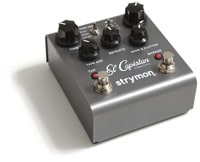 Soon we will be releasing our El Capistan dTape™ Echo. To capture the full experience and complexity of a tape echo machine, every last tape system attribute was relentlessly studied and faithfully recreated. The result is Strymon dTape™ Technology. Pete Celi, our Lead DSP Engineer and Sound Designer illustrates the research and sound design process in the White Paper below.
Soon we will be releasing our El Capistan dTape™ Echo. To capture the full experience and complexity of a tape echo machine, every last tape system attribute was relentlessly studied and faithfully recreated. The result is Strymon dTape™ Technology. Pete Celi, our Lead DSP Engineer and Sound Designer illustrates the research and sound design process in the White Paper below.
Tape Echo Overview
Tape Echo Machines work similarly to traditional tape recorders, using electromagnetic heads to record, play back, and erase audio on a magnetic tape. A tape echo machine mixes the input with the playback signal, and adds the ability to send the playback signal back to the record head to get re-recorded (and played back) repeatedly, creating an echo effect. The time between these echoes is a function of the tape speed and the distance between the record and playback heads.
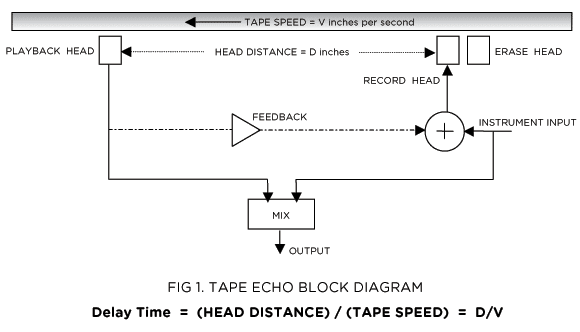
As can be seen from the above equation, the echo time can be changed by changing the tape speed or by changing the distance between the record and playback heads. As a result, there are two types of tape echo machines – variable tape speed with fixed heads (most notably the Roland Space Echo*), and fixed tape speed with moveable heads (most notably the Maestro Echoplex*). A variable tape speed machine may have multiple fixed heads that can be selected, and a moveable head machine may allow two or more discrete tape speeds. We’ll look at the sonic implications, similarities and differences of these two different categories of tape echo machines in a bit.
Sonic Qualities
Part of the allure of the vintage tape echo units is the way the characteristic imperfections of the system affect the sound of the echoes. Tape echo units are mechanical systems that involve motors and moving parts that are subject to alignment issues, friction, aging, warping, etc. Additionally, the recording medium itself – magnetic tape – is prone to degradation and wear in a variety of manners, even in the presence of a (non-existent) perfectly tuned mechanical system.
Mechanical Contribution
The tape makes its way from the record head to the playback head by the effect of a motor-driven capstan and a pinch roller, which effectively ‘squeeze’ and pull the tape. Tape speed variations can be introduced by fluctuations in motor voltage, deformity of the pinch roller, bent capstan, maladjusted tensioner, worn bearings, and the list goes on. Since the delay time is directly related to the tape speed, any inconsistencies in the tape speed will result in inconsistency of the delay time. A small variation in delay time wouldn’t itself be noticeable, but variations in tape speed also results in variations in playback pitch, which is quite noticeable, even at small levels. The presence of some level of tape speed variation contributes greatly to the ‘three dimensional’ quality attributed to tape echo machines.
Tape Quality
The quality and age of the tape itself will have a noticeable impact on the sound of the echoes. Old tape that has surface contaminants can cause deviations in the tape speed as the tape can ‘catch’ briefly due to friction effects. This effect occurs at higher frequencies than that of motor and pinch-roller deviations, and can result in a ‘garbled’ sonic quality. Tape splices and sections of tape that have been creased also will also impact the echo sound.
With old tape, or tape formulations of inferior quality, the ability of the tape to be magnetized at high frequencies is impaired, resulting in overall ‘dark’ repeats, and sections of ‘dropout’ where the bandwidth is severely reduced for brief periods. The effect is progressive when high levels of feedback are used to generate many repeats.
Bias
Magnetic tape is a highly non-linear recording medium. There is a threshold below which signals cannot be recorded, causing objectionable crossover-distortion. To overcome this problem, a ‘bias’ signal is introduced. The bias signal is a high (inaudible) frequency tone that is added to the desired record signal. This allows the desired signal to be recorded in the linear region of the tape and avoid the crossover-distortion region, even when the desired record signal is small, provided the amplitude of the bias signal is large enough. The bias tone is removed with a low pass filter during playback.
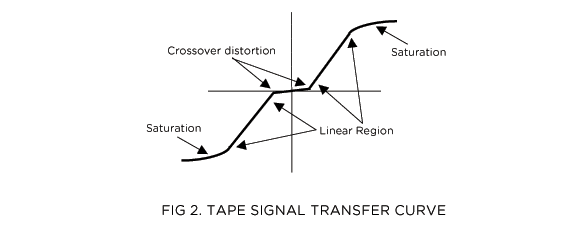
When recording large signals, the tape will saturate and cause soft-clipping distortion as the tape is unable to become further magnetized. From this standpoint, it is desirable to limit the size of the signal being recorded to the tape. This, however, is in conflict with the bias signal whose purpose is to write large signals to the tape to avoid crossover distortion. Thus the bias level plays an important part of tape recording quality. Some prefer to intentionally set the bias higher or lower than the recommended specification to achieve a particular sound that suits their preferences or particular equipment setup. Higher bias levels result in reduced echo volume and limited headroom, as more of the linear region is ‘used up’ for the bias signal. This causes the echoes to quickly degenerate into a wash of saturated harmonics with higher feedback settings. Lower bias settings (just above the crossover distortion point) result in the cleanest echoes with the most headroom, suitable when high fidelity of the echoes is desired.
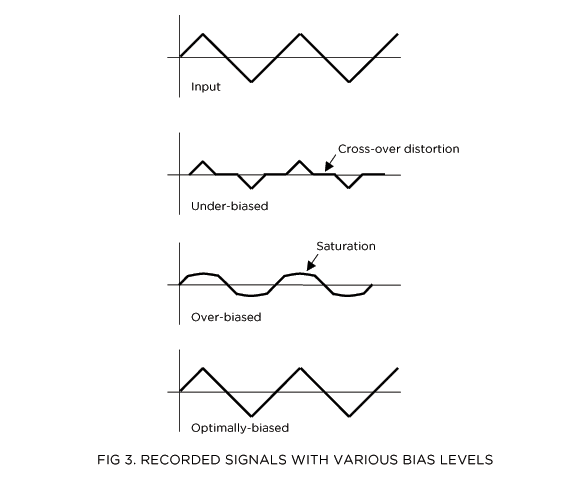
Tape Speed
The speed of the tape also impacts the fidelity of the echoes. The playback head reads the magnetized signal on the tape contained within a narrow window, or aperture, and the resultant playback signal is the average magnetic signal contained within the aperture. With high-frequency signals, both positive and negative parts of the waveform will be contained within the aperture and the two halves will start to cancel each other out. The playback signal will have a high-frequency roll-off as a result. As the tape speed is reduced, this effect will start to happen at lower frequencies. This results in darker echo signals as the tape speed is reduced.
Tape speed also plays a role in how the mechanical and tape quality imperfections impact the record and playback sound. Pinch-roller deformities and capstan problems result in quasi-periodic speed fluctuations that are directly proportional to tape speed. Tape friction and maladjusted tensioners may cause more problems at lower tape speeds as various friction components are relatively more difficult to overcome at lower speeds.
Tape Echo Machine Types in More Detail
The variable tape speed and moving head machines react differently to some of the factors discussed. Next we’ll look at each type of unit in more detail.
Variable-Tape-Speed Machines
As the tape speed is slowed to increase the delay time, the repeats will get darker due to the playback magnetic aperture effect. The low-frequency fluctuations of the mechanical system will also slow down proportionally with the tape speed, so the wow and flutter effects might be noticed more as ‘pitch warbling’ as opposed to ‘dimensional depth’. The higher frequency deviations contributed by the tape itself will also slow down and become more noticeable as a ‘garbled’ sound at lower tape speeds.
This degrading of sound at slower tape speeds led to the inclusion of multiple heads to extend the overall range of delay times. A playback head placed close to the write head provides short delays for slap, rockabilly, and spacey sci-fi sounds. A playback head placed further away from the write head provides longer delays. Additional combinations of the playback heads can be activated simultaneously for rhythmic echo sounds.
When the delay time is adjusted with repeating echoes present, the varying tape speed will result in pitch deviations proportional to the change in tape speed. So doubling the tape speed (cutting the delay time in half) will result in the repeating echoes being pitched up by one octave as they continue to get played back and re-recorded to the tape. Bringing the delay time back to its original point will bring the repeated echoes back to their original pitch, and any echoes recorded at the higher speed would be pitched down one octave. Since the heads are fixed, the signal gets recorded to the tape at the same speed that it is being read from the playback head, even when the delay time is changing. We’ll see how this differs from the variable head machines next.
Moving-Head Machines
Moving-head machines don’t exhibit any change in repeat quality or variations in wow and flutter characteristics as the delay time is changed. These characteristics are determined solely by the tape speed, which stays constant. However, the tradeoff of maximum delay time vs. overall repeat quality is still present. Practical constraints on physical size determine the maximum distance between the read and write heads, so the maximum delay time depends on the tape speed that is chosen for the system. Long delay times require a slower speed which results in reduced echo quality for all delay times. Higher tape speeds produce higher quality echoes but limit maximum delay times. As a result, some moving head designs allow for a selection of multiple tape speeds to extend versatility.
The most well-known movable-head machines have a fixed playback head and a movable record head. In this type of system, several interesting things happen when the delay time is changed (by moving the record head) with repeating echoes already playing back. When the record head is moved, the relative speed of the tape at the record head is the difference between the tape speed and the speed at which the record head is being moved. The echoes are re-recorded onto the tape at a different speed relative to the stationary playback head. This results in a pitch artifact that is dependent on how fast the record head is moved and independent of change in overall delay time. Moving the record head back to the original delay time will not restore the original signal, even if the record head is moved back in exactly the reverse manner in which it was originally moved. This is because the actual length of tape between the heads changes with delay time, unlike the variable-tape-speed machines. Also, since it’s the record head that is moving, we won’t hear the effect of the delay change until that section of tape reaches the playback head.
Another ‘feature’ is that with longer delays and some dead space between repeats, you can move the write head towards the read head during the playback of the dead space (quickly, chasing the repeat signal that just got written) so that the subsequent shorter repeats happen without any noticeable pitch effects at all.
Strymon dTape™ Technology
To fully capture the experience of a tape echo machine, all of the attributes of the systems listed above must be accounted for. The result is Strymon dTape Technology.
Representation of Mechanical System
The mechanical systems of tape echo machines were thoroughly studied to accurately capture the nature of their imperfections. Multiple levels of quasi-periodic fluctuations from motors and mechanical components occur with pseudo-random fluctuations that span several decades of frequency disturbances. Some of these disturbances occur at both heads simultaneously, while others occur at the heads independently.
To allow for any type of tape machine to be re-created, dTape Technology allows for independent control of tape speed for each head in the system, along with independent control of head position. In this manner, heads can be fixed with varying tape speed, or tape speed can be fixed with variable head position. This powerful ‘super system’ also allows for realistic implementation of the mechanical imperfections that occur. For example, the record and playback heads can experience different instantaneous tape speeds if the tape binds momentarily. A motor fluctuation will result in a tape speed disturbance that is experienced by both heads simultaneously. A tape defect will travel from the record head to the playback head. These effects happen naturally in the dTape system, which allows for user control from ‘perfectly tuned’ to ‘in need of service’.
Additionally, the dTape system allows for independent control of the motor/mechanical disturbances and the tape friction disturbances. As the tape becomes smoother, its influence on tape speed diminishes. A tape with no contaminants, splices, or creases can be achieved by reducing the tape/friction component to zero. This ‘perfectly smooth tape’ is representative of a magnetic drum type of recorder, which operates on the same electromagnetic principles of a tape system, but uses a revolving magnetized drum as its recording medium.
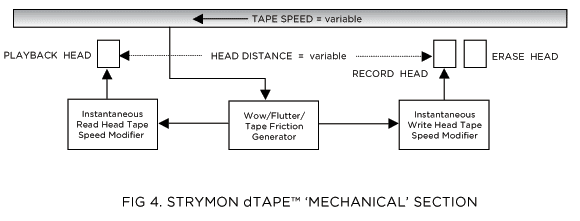
Tape Speed
The effect of tape speed, including aperture-related bandwidth effects and frequency scaling of mechanical wow and flutter is fully accounted for in the dTape system. In variable tape-speed modes, repeats degrade and wow and flutter tracks as tape speed is modified. In movable-head modes, repeat quality and wow and flutter remains constant as the delay time is varied. Selection of a different tape speed results in an accompanying change in bandwidth and wow and flutter characteristics.
Bias Level
Bias level adjustment is a significant contributor to the character of the repeats. Strymon dTape faithfully recreates the bias adjustment from under biased to over-biased. As the bias level is increased, the headroom and level of the repeats is reduced. The bias can be adjusted to allow for easy transition into saturated oscillation without an increase in the volume level of the saturated repeats. Lower bias settings work well with hot input signals, while lower level inputs can tolerate higher bias settings.
Tape Bandwidth
In addition to playback-head aperture effect, the frequency characteristics of the repeats are determined by the actual tape bandwidth, system filtering and head-tape alignment. Older tapes will have a lower bandwidth with a warmer top end. Misalignment of the heads can also greatly reduce the high end. The low frequency characteristics result from a combination of the electro-magnetic properties of the record/playback process, and the system filters. The overall result is a reduction of low frequency content.
The dTape algorithm allows for independent tailoring of the high- and low-frequency content of the repeat signal, allowing for repeats characteristics that range from full-bandwidth, to dark and warm, to the extremely high-passed nature of some magnetic drum recorders.
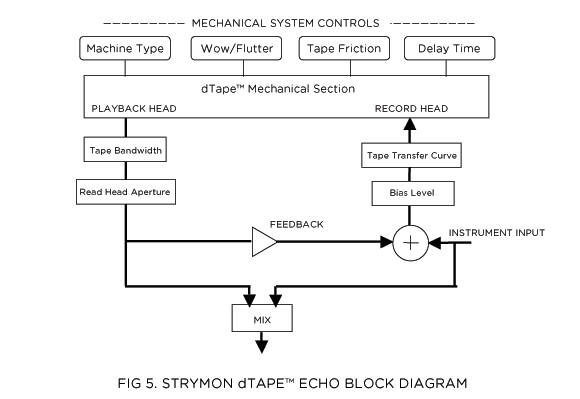
Summary
The various complexities of tape machines all contribute to the overall experience. When they are all accounted for accurately, the experience can be re-created with quality and reliability. Strymon dTape Technology allows for various tape machine types to be re-created authentically, including the wow and flutter, tape friction, bias adjustment, oscillation, saturation, and delay-time-adjustment artifacts. Furthermore, user adjustment of the parameters allows for a range of tape experiences unattainable with a single traditional tape machine.
*All product names used in this article are trademarks of their respective owners, which are in no way associated or affiliated with Strymon or Damage Control, LLC.
Subscribe to our newsletter to be the first to hear about new Strymon products, artist features, and behind the scenes content!

Strymon co-founder Pete Celi is responsible for the sound design and DSP algorithm creation for all the Strymon pedals that use DSP. Recently I had the
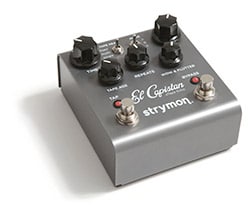
Welcome to the first installment of our new Strymon Gear Guide series! I will be providing tips and tricks on using and understanding the various
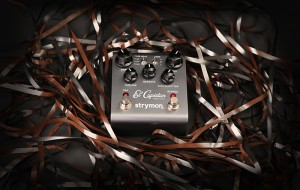
If you have an El Capistan on your pedalboard, you’ve probably spent some time having fun with the Sound on Sound mode. This mode is
11 Responses
Looks good! Possibly the first echo pedal that may meet my expectations. How much will it cost?….
@sam – El Capistan will sell for $299 US. Thanks! 🙂
Will it have a tap tempo?
What will the max delay time be?
If it can multitap (1/4 then dotted 1/8ths) then I’ll buy it and replace the memory lane on my pedlboard.
My birthday is 7/30, how’s about releasing the pedal so I can haz it? kaybyethanx
Got my El Capistan pedal today. BRILLIANT!!!!! BLOWN AWAY!!!
Never mind the repeats ‘n reverb, would this pedal be practical as a striaght “tape sim” emulator in the studio? Is there any hysteresis modeling? Do overdriven signals get duller, as with real tape?
I’ll be going to the US on February 2011. so you guys have until February to put it back on stock, otherwise I’ll scream. =D
allas says:
August 26, 2010 at 7:20 pm
Never mind the repeats ‘n reverb, would this pedal be practical as a striaght “tape sim” emulator in the studio? Is there any hysteresis modeling? Do overdriven signals get duller, as with real tape?
second that question!
Not sure but this reacts so close to a tape mach, I wouldn’t doubt it.
i now own this pedal..and it is a pretty cool tape sim…and the looping mode allows for fun sound design abilities.
Funnest pedal I own!